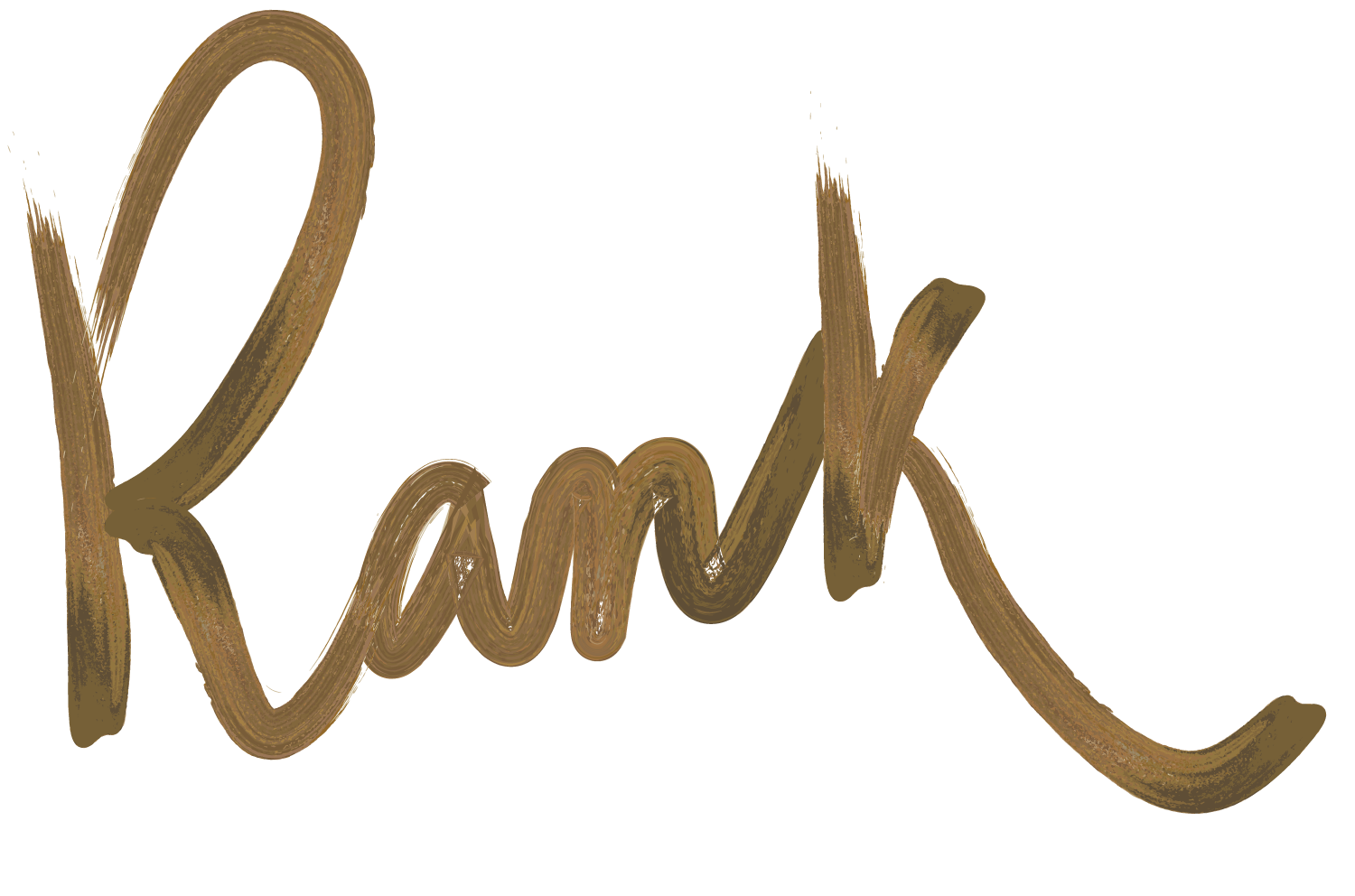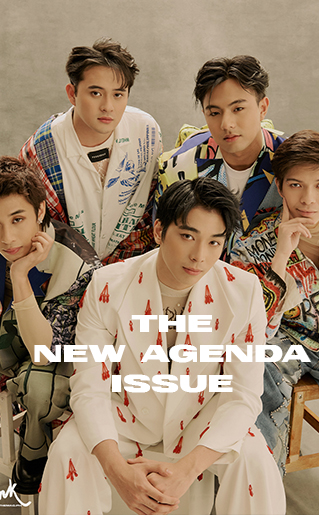MANILA, Philippines — Amid the trying times brought by the unprecedented halt to life as we know it due to the raging global pandemic, the storied tradition of excellence by the Metrobank Foundation, Inc. (MBFI) remains unwavering in its dedication to foster, harness, and champion Filipino artistry and creativity. This is once again showcased in its annual recognition programs for Filipino visual artists—painters and sculptors—with the return of the Metrobank Art & Design Excellence (MADE) this year.
On its 37th year, MADE adopted the theme “Spectrum: The Art of Possibilities” inviting every Filipino artist to tap into the expansive realm of creativity and transpose their spectrum of ideas into works that mirror the human experience and reshape the world anew. With this, MADE continues to be a purveyor of the visual arts, amplifying the reach and voice of local talents and visionaries—depicting present day realities.
More than just a pioneering corporate social responsibility (CSR) program for the arts, MADE has evolved to become a development program that facilitates the generation of ideas promoting social development, appreciation and preservation of our cultural heritage, as well as making art accessible to the many through its various art education activities and events.
To affirm its commitment, MBFI remained a supporter of local visual artists who were constrained by the challenges of these unusual times. This started by a cash assistance program dubbed as MADE CARES (Community Aid and Relief for Emergency Situations), which was implemented, benefitting over 200 artists from the PhP1 million financial aid, especially at the height of the pandemic.
“When our lives were suddenly disrupted by the pandemic, the competition was deferred last year. Now as we are learning to live with the reality of COVID-19, we continue our mission to nurture the potential of young artists and enable them to express their voices freely however restrictive this new normal,” shares MBFI president Aniceto Sobrepeña.
“The hundreds of entries submitted across the country are a testament to our local artists’ passion to create. They convey visually the heartbeat of a people facing a global disease, the fears, the anger, the sadness and loss, but also the hope, the courage and the tenacity to fight this enemy with kindness, generosity and compassion,” he added.
Established on January 8, 1979 by Dr. George S. K. Ty, sixteen (16) years after foundation of the Metropolitan Bank & Trust Company (Metrobank), the Metrobank Foundation, Inc. (MBFI) has since envisioned to be the country’s premier corporate philanthropic foundation contributing a significant impact on social development.
Its flagship programs include the Metrobank Foundation Outstanding Filipinos; Metrobank Art & Design Excellence (MADE); Metrobank Scholarship Program (MSP); Metrobank MTAP- DepEd Math Challenge (MMC); Grants and Social Development Partnerships, Disaster Response, National Teachers’ Month (NTM) celebration, and the Metrobank Foundation Professorial Chair Lectures. MBFI is also the principal owner of the Manila Doctors Hospital (MDH), one of the leading centers of wellness in the country.
This year, MADE recorded the highest number of entries in the last 10 years with a record-breaking 701 entries—564 entries for the Oil on Canvas Category; 77 entries for the Water Media on Paper Category; and 60 entries for the Sculpture Recognition Program.
Out of these entries, eight (8) Filipino painters and sculptors emerged as this year’s batch of MADE awardees. Two (2) Grand Awardees for the Painting Recognition Program and one (1) Grand Awardee for the Sculpture Recognition Program were chosen by the Final Board of Judges to receive a prize of PhP 500,000.00. While another three (3) artists for the Painting Recognition Program and two (2) for Sculpture Recognition Program received the Special Citation with each receiving a prize of PhP 100,000.00.
Apart from this, all awardees are slated to receive the “Mula” glass trophy designed by 2009 Metrobank Prize for Achievement in Sculpture (MPAS) awardee Noell El Farol. They will also become members of the MADE-Network of Winners, the alumni organization of past awardees, implementing pay-it-forward projects that cater to marginalized sectors.

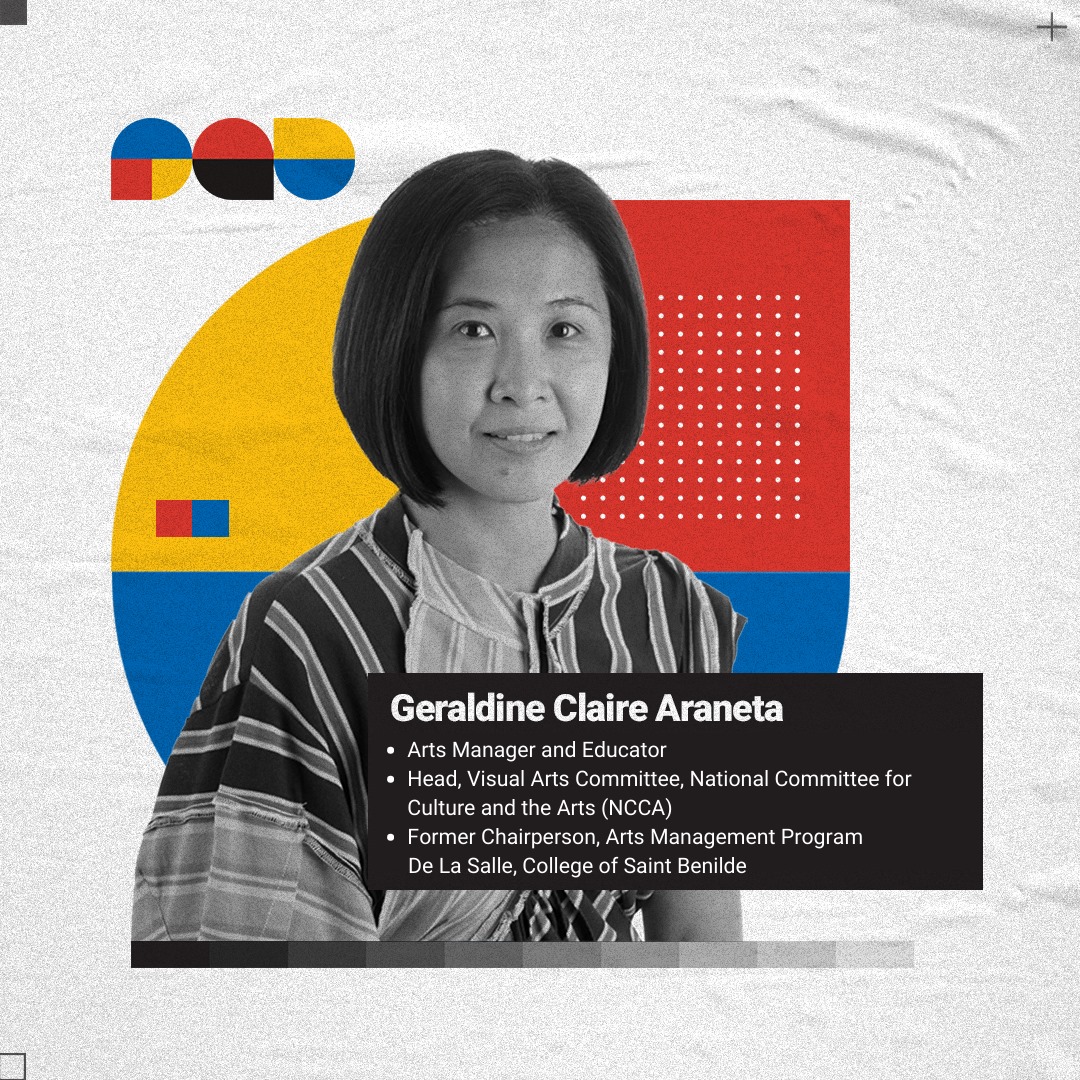


The final Board of Judges was chaired by well-known painter, installation artist, art educator, and sculptor Toym Imao. Members of the Board included Art Fair Philippines co-founder Dindin Araneta; product designer and metal sculptor Daniel de la Cruz; Cultural Center of the Philippines Visual Arts and Museum Division Office-in-Charge Rica Estrada; intermedia artist Mark Salvatus; and interdisciplinary artist Josephine Turalba.
The late visual artist Leo Abaya also served as a part of the board of jurors until his passing last May.

“This year’s selection does not disappoint in the array of styles and themes depicted. We see paintings that show sophisticated use of color and works that require a high degree of technical skill. Figurative works still dominate much of the selection, as do works that present social plights and the harsh realities of daily life,” shares juror Rica Estrada in her curator’s note.
“The paintings and sculptures speak of anxieties, loss of livelihood, worries about the future, depression, stress, difficult home situations, and the act of keeping afloat,” she added.
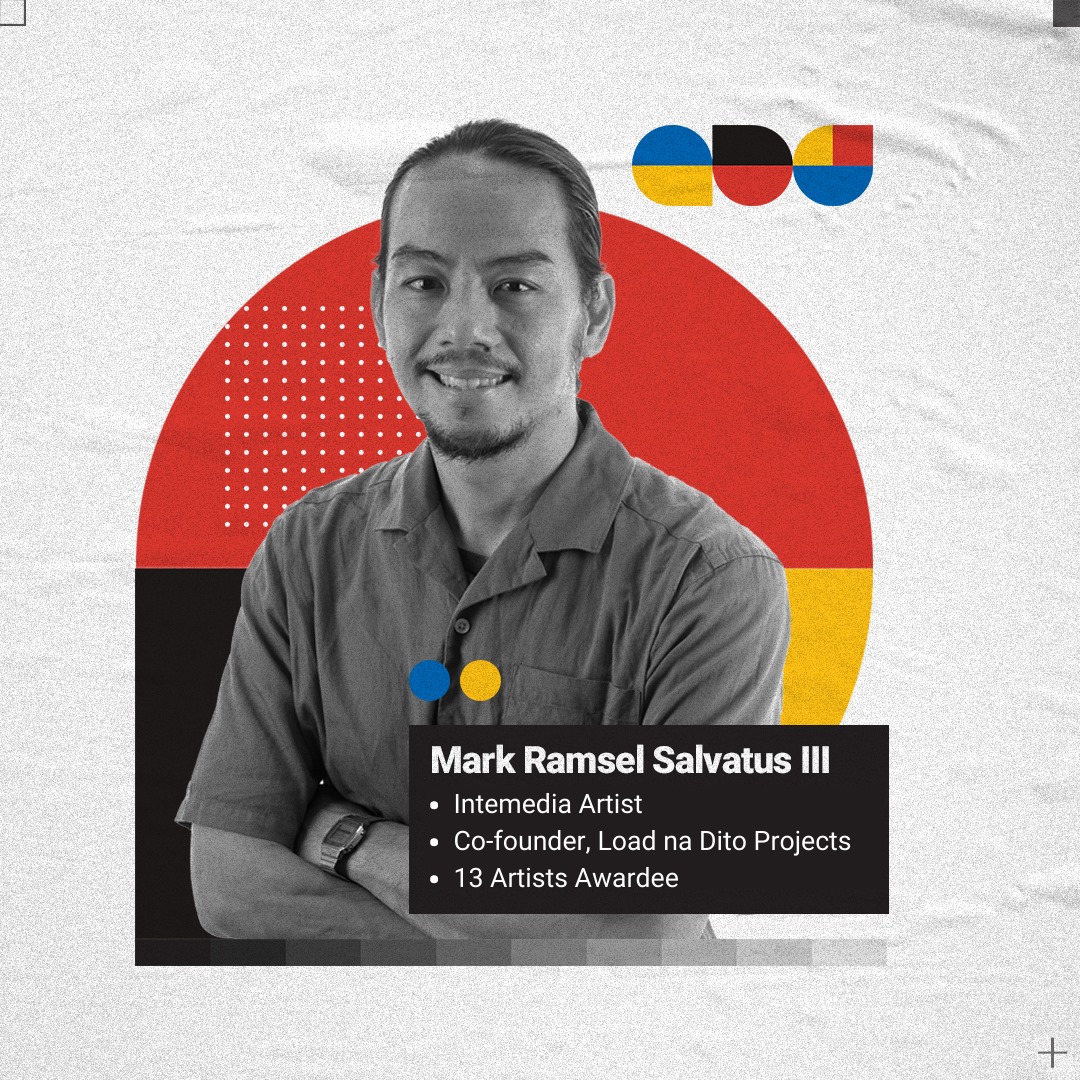
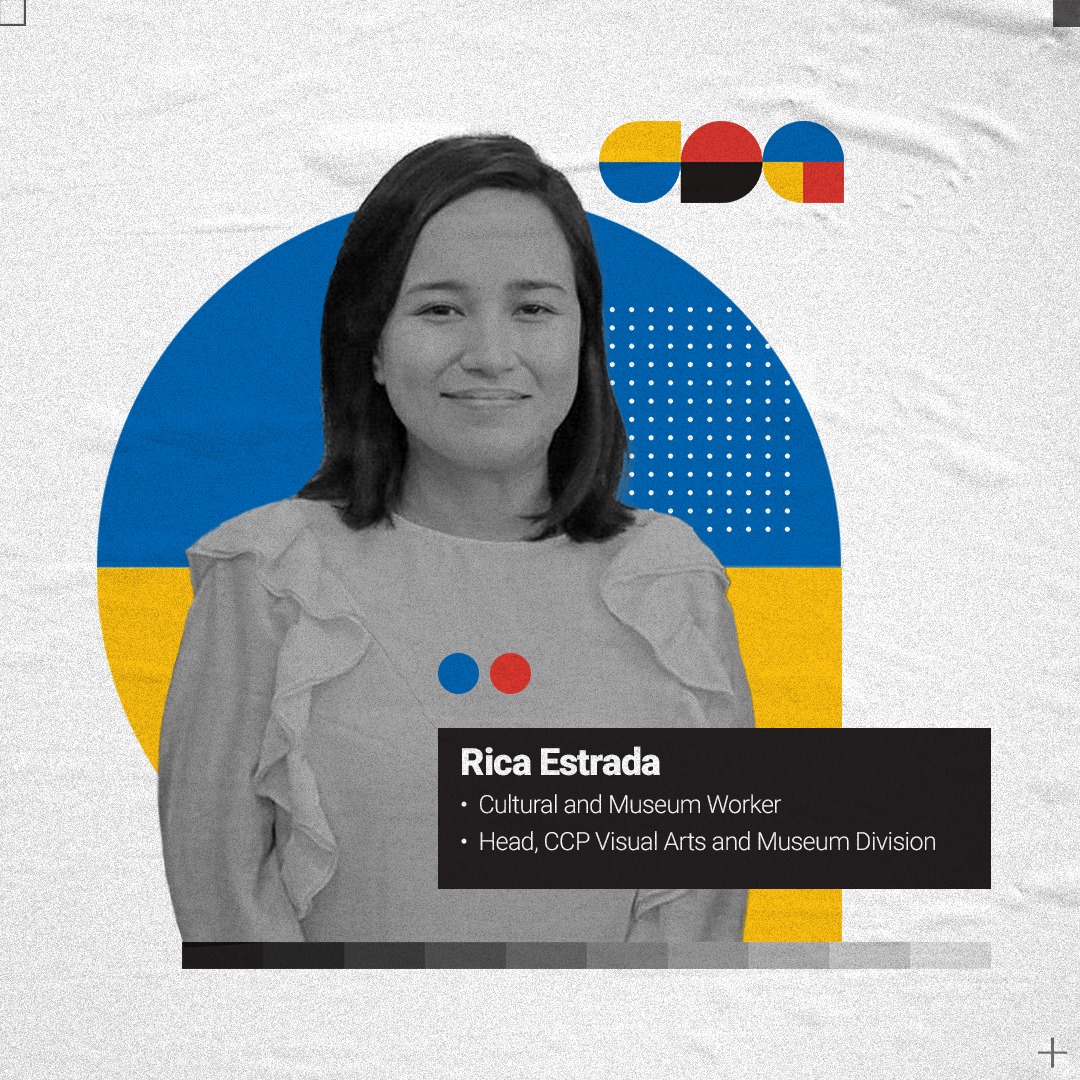
Awardees will be formally recognized during a virtual Awarding Ceremony & Exhibit Opening on September 16, 2021, 5:00PM in line with Metrobank’s 59th anniversary celebration.
Given restrictions of holding on-ground events, MADE has also maximized the use of social media to continue and forge the road of its continuing advocacy. Through #SpectrumMADE2021, a year-long social media campaign was introduced to bring art experience and art education to its stakeholders amidst the pandemic.
A series of online activities were lined up throughout the year such as webinars and artist’s talks. For this month’s offering, a landmark webinar series will be held on September 18 and 25, with the themes “Art and Design During Crisis” and “The Creative Industries for Social Impact,” respectively.
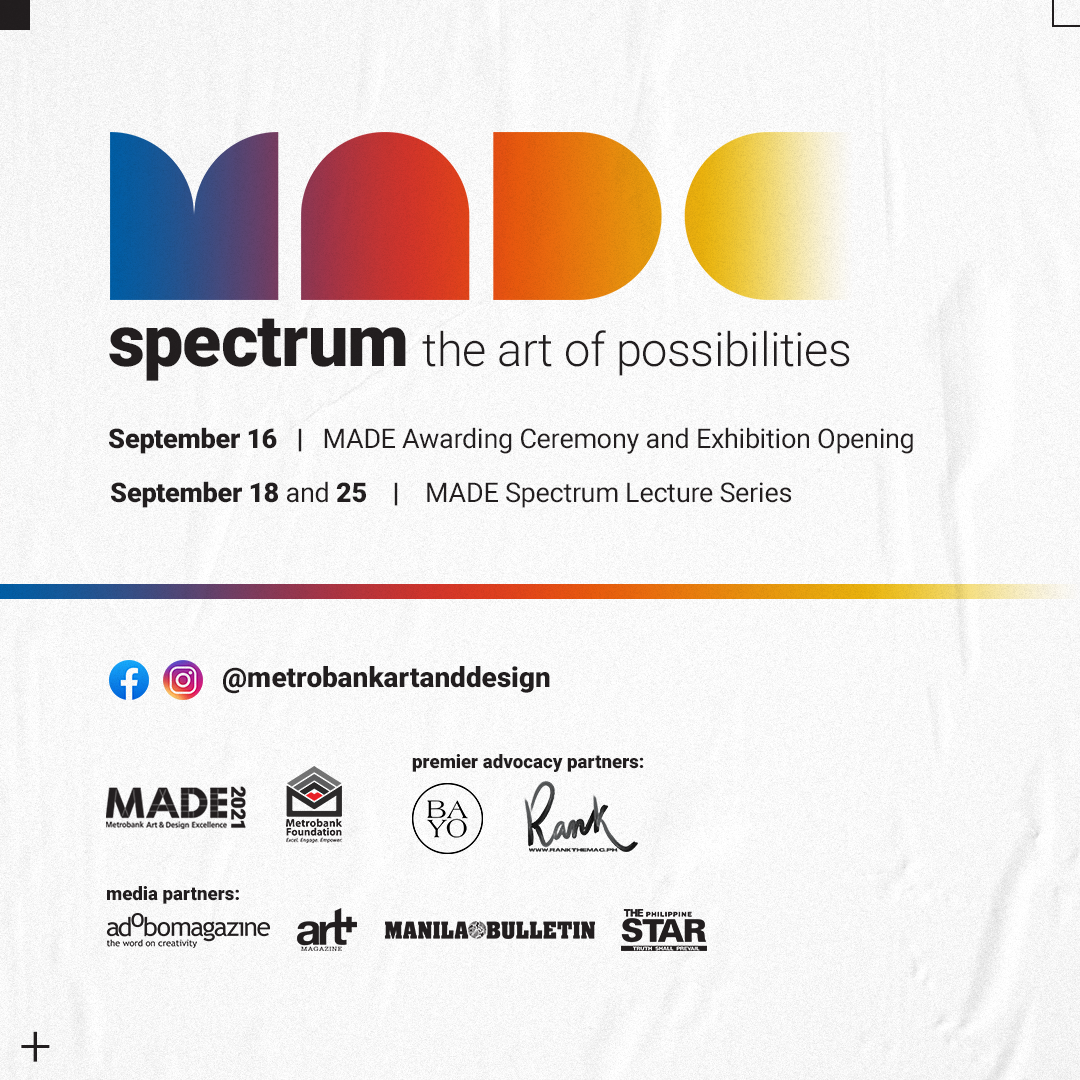
Launched in 1984, MADE has long served as a platform for discovery of the most passionate and persistent creative visionaries in the country. To date, more than 400 visual artists and design professionals have been recognized and given the launchpad for their now-illustrious careers not just as artists, but as foremost culture-shapers indicted in the annals of the country’s rich art history.
A majority of these awarded artists have since carved significant names and indelible marks in the local and even international art and design scenes. Past awardees include Elmer Borlongan, Mark Justiniani, Leeroy New, Alfredo Esquillo, Andres Barrioquinto, Yeo Kaa, and Cedrick dela Paz, to name a few.
In 2021, joining the pantheon of top visual artists christened and celebrated by MADE, here are the winning pieces that have captured the jury’s acclaim:
PAINTING RECOGNITION PROGRAM
Oil/ Acrylic on Canvas Category
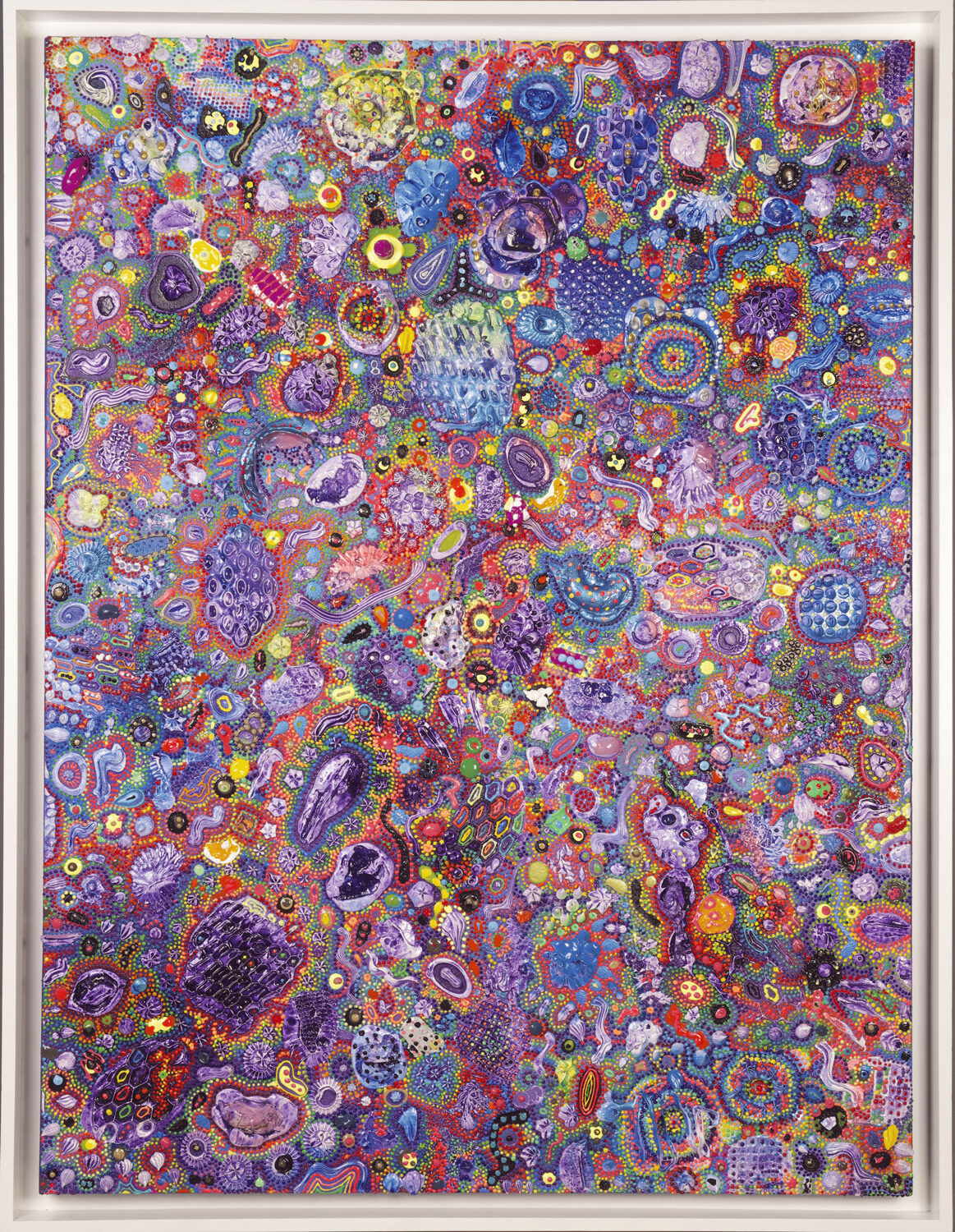

Grand Awardee
Ariosto Dale C. Bagtas
“BETWEEN HEAVEN AND EARTH”
Acrylic on Canvas 48” x 36”
The Grand Awardee in the Oil/Acrylic on Canvas category, Ariosto Dale Bagtas visually renders the pandemic in his work, Between Heaven and Earth. Composed of organic shapes in dazzling colors, the work may be viewed as a stylized version of the virus on a cellular level—a ringing representation of people who have come together to defeat the virus, or a collection of healing vortices of “people who seek comfort and help in sickness and pain, restore their health, and live a second chance that God has given them: a chance to be blessed, experience happiness, and live to the fullest.”
The abstraction of the work essays complexity on a microcosmic and macrocosmic level. It is full of mutations, growth, and transformations, underscoring how the impetus of life is movement. This is heightened by how the artist has built up the composition without any seeming premeditated design and order, guided only by intuition and the desire to create something that resists the quotation of recognizable forms.
As such, the sensibility of the piece is drawn inwards, similar to the pursuit of abstract artists who seek to express the ineffable through shapes and colors. Bagtas’ manner of expression is ultimately contemporary, with its all-over approach and use of a highly saturated color palette, which recalls vibrant tapestries. In creating his own visual language, the artist allows a space for the viewer to establish a web of associations, perhaps in unison with the thematic preoccupations of the artist: “happiness despite of sadness, love despite of hatred, and prosperity despite of hardship.”
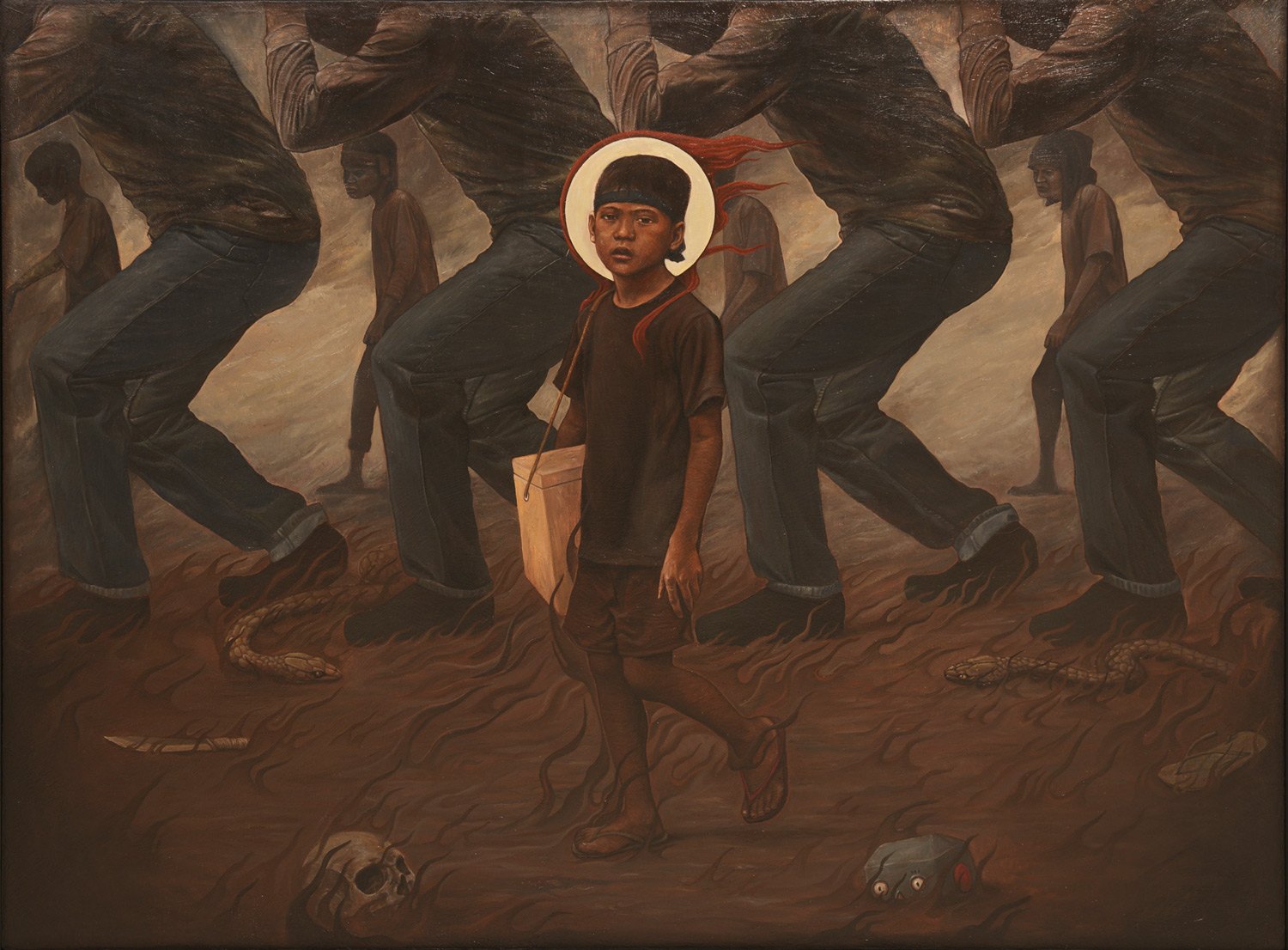
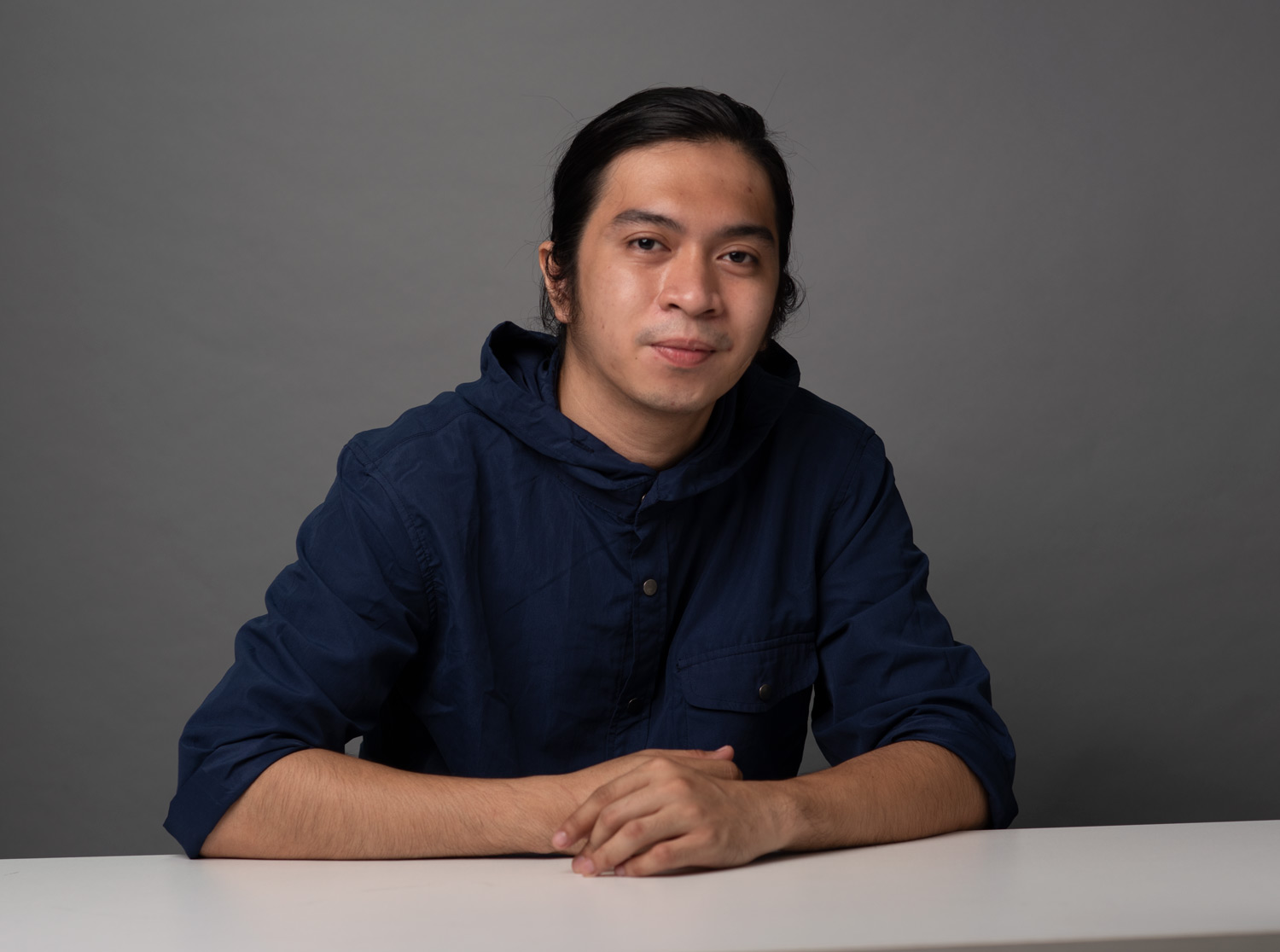
Special Citation
Mark Anthony P. Laza
“BINYAG SA LANDAS-APOY “
Oil on Canvas
36” x 48”
In Binyag sa Landas-apoy, Mark Anthony Laza, who receives a Special Citation in the Oil/Acrylic on Canvas category, provides a striking view of innocence and the road to awakening in the life of a child. Calling his work a “symbolic adaptation of a period in our lives,” the artist captures the moment in which a young boy—a peddler of cold delights contained in his icebox—is about to encounter a transformative moment—the trial by fire alluded to in the title.
The child, as a protagonist, seems to be aware of this impending event, as he looks squarely at the viewer. His purity, as suggested by the halo, is about to be consumed by flames. Soon, he will join the countless and nameless proletariat, in lockstep with each other, either carrying the burden of their labor or about to proceed with their own emancipation. Whatever their collective action hopes to achieve, it is not to be an easy task as snakes slither in the flame-like grass, which indicate the danger. A bladed weapon lies on the ground, suggesting that the struggle may be steeped in violence and blood.
The work, which evokes visual rhythm through the almost symmetrical depiction of the figures, hews closely to the ethos of Social Realism. The use of sepia tones renders the scene a sobering look. Through elements that place the centrality of human agency, the painting conveys the inheritance of hardship and poverty as well as a view of how this vicious cycle, through collective action, may be broken.
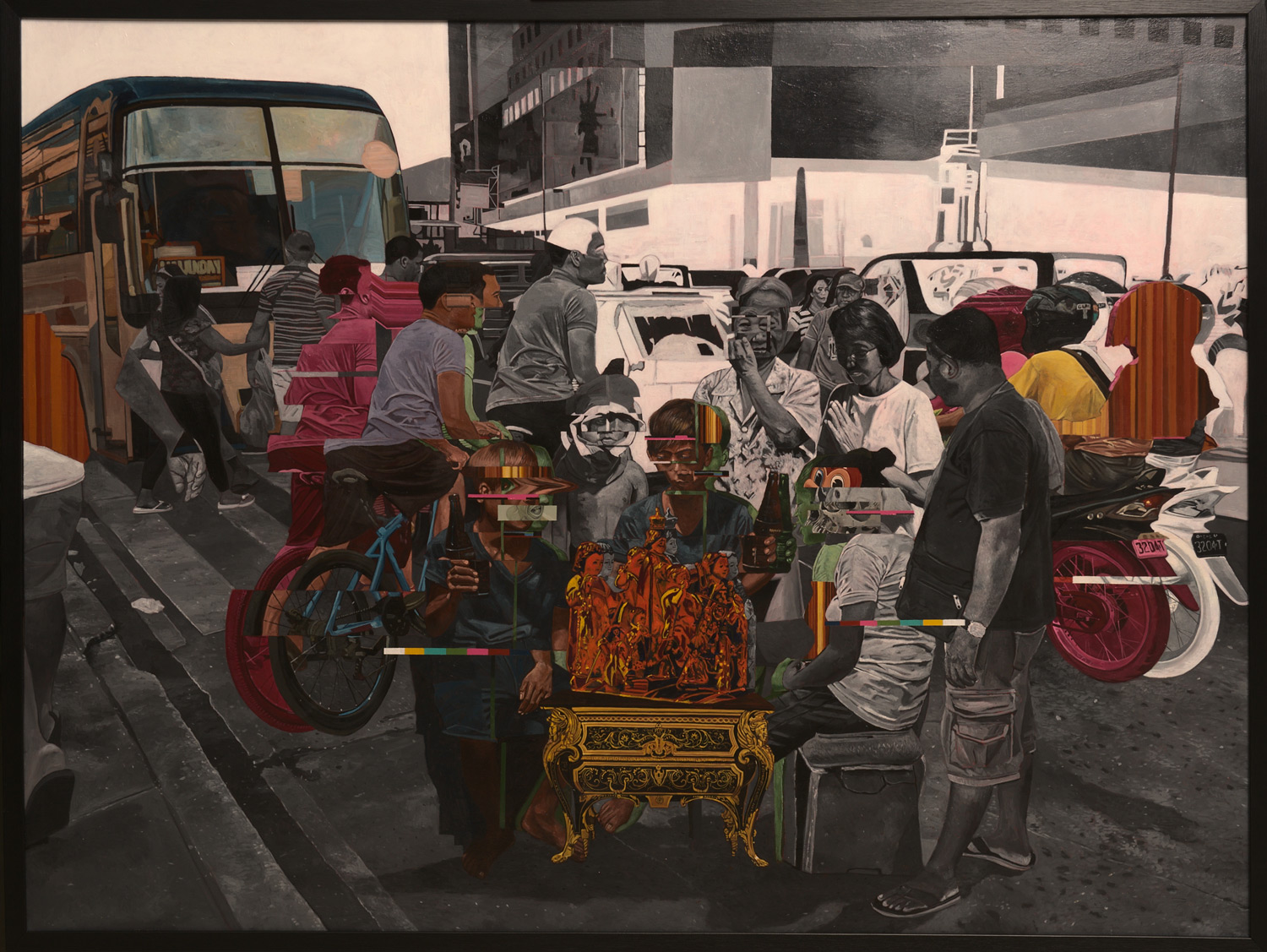

Special Citation
Clark S. Manalo
“UNCENSORED FALLACY OF FAITH”
Acrylic on Canvas
36” x 48”
Clark Manalo, recipient of Special Citation in the Oil/Acrylic on Canvas category, questions our ability to fasten our beliefs on intangible things, in his work, Uncensored Fallacy of Faith. “It’s hard to determine what is true and what is not,” the artist states. “Like faith, we cannot easily acknowledge if it is genuine or we’re only going with the flow of society and maintaining the work of the flesh.” For the young artist, the nature and function of faith is tested especially in contemporary society stricken with the pandemic.
In his piece, a group of kids thronging in front of an altar situated in the middle of a road is displayed, framed by a bustling metropolis. On the altar, rest the icons of the child Jesus which seem to have been reduced as seductive commodities. With their faces rendered as screen glitches, the kids are portrayed beyond their years, with how they casually hold beer bottles. It is a disconcerting sight, as if they are unwary of the world around them, too reliant on what faith could bring.
The children evince the “fallacy of faith” underscored by the title, of how it has become a mere demonstration of piety and not of meaningful action. The overreliance on faith perpetuates poverty. (After all, everything is now consigned to the ministrations of Divine Providence.) The artist brings to life a tale on morality to a contemporary audience, critiquing the place of blind belief in the difficult world we live in.
Water Media on Paper Category
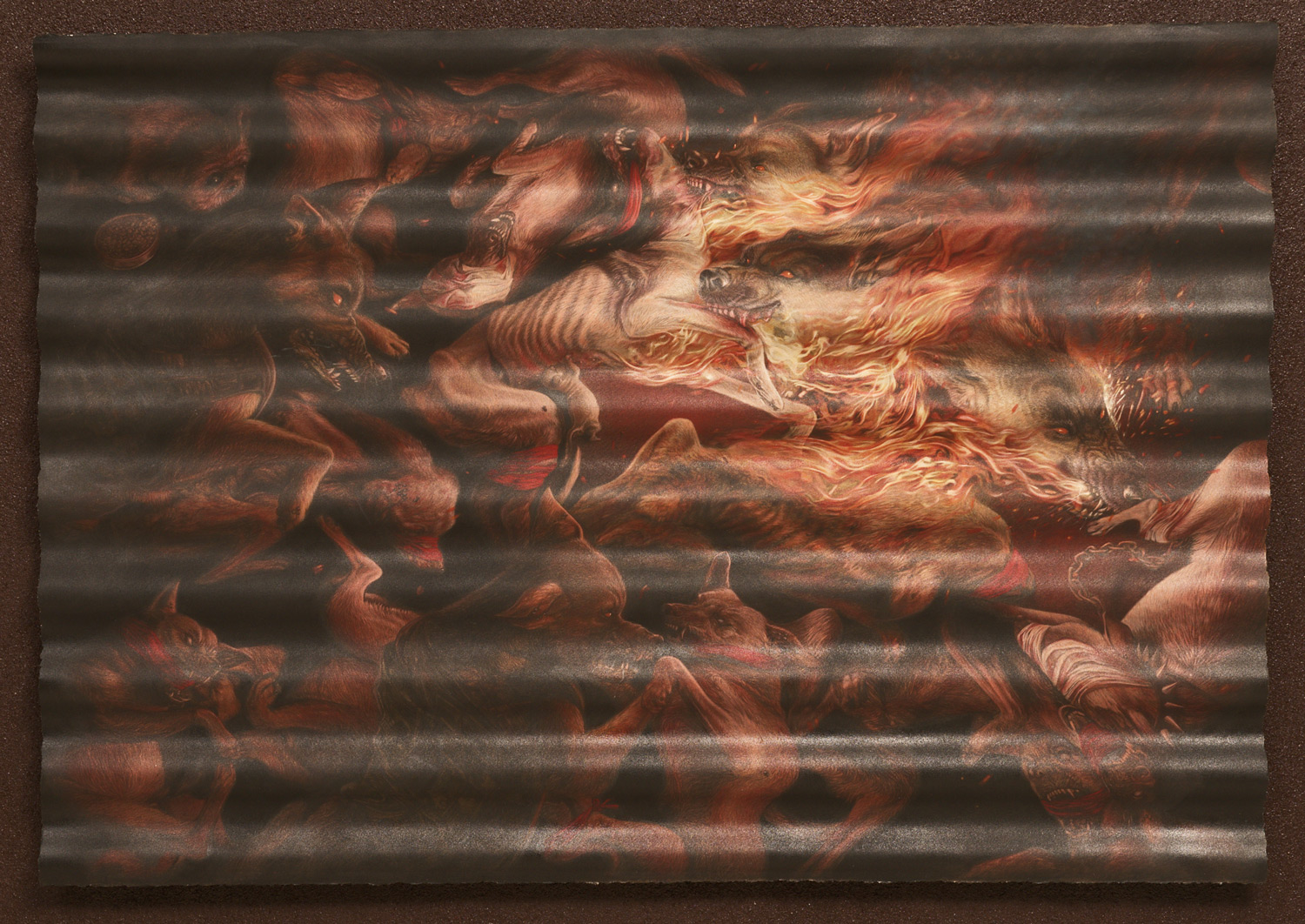
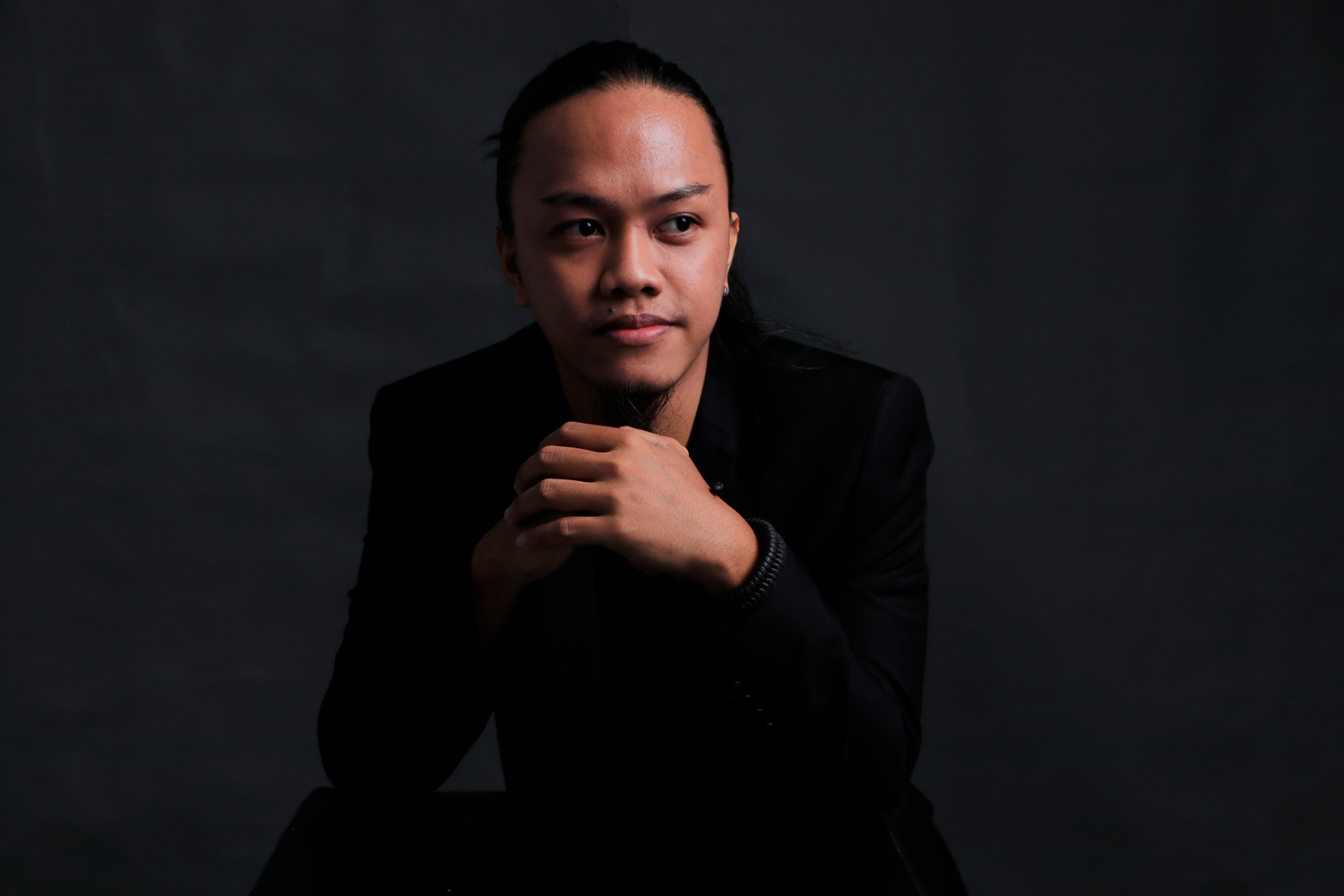
Grand Awardee
Lymuel A. Bautista
“HAUNTING WAIL OF CHAOS”
Water Media on Paper
30” x 40”
Lymuel Aguilar Bautista, hailed the Grand Awardee in the Water media on Paper category, depicts a visual fable how the bane of the pandemic intersects with societal ills in his work, Haunting Wail of Chaos. The painting, states the artist, is “a commentary on the confusion that has brought horror and grief to the country” and “an awakening that needs to be felt not only by those who are vigorously fighting, but especially by those who are blind to what’s happening around them.”
With the paper medium shaped like corrugated iron, the work presents a view of an inferno teeming with dogs. Some have already succumbed to their injuries as others continue to terrorize the pack. The work may be read as dog-eat-dog world, in which there is no cooperation, only competition and the underlying toxicity in a winner-takes-all mentality. In the midst of the dogs savaging those less powerful them, ticks, which represent the coronavirus, infect them. This is a striking critique on how state efforts appear to have been devoted more on politicking, red-tagging, and pushing for futile, selfish pursuits than curbing the pandemic.
The painting’s overall composition is hectic, disconcerting, but magnificent in its chaos. The rabidity of the scene is almost Biblical in its depiction of cataclysm, offering an unstinting view of human nature evoked more powerfully through the vehicle of an allegory. Despite the seeming helplessness of the scene, the artist believes that “the time when our freedoms are curtailed is not the time for fear and silence; it is the time for standing up.”
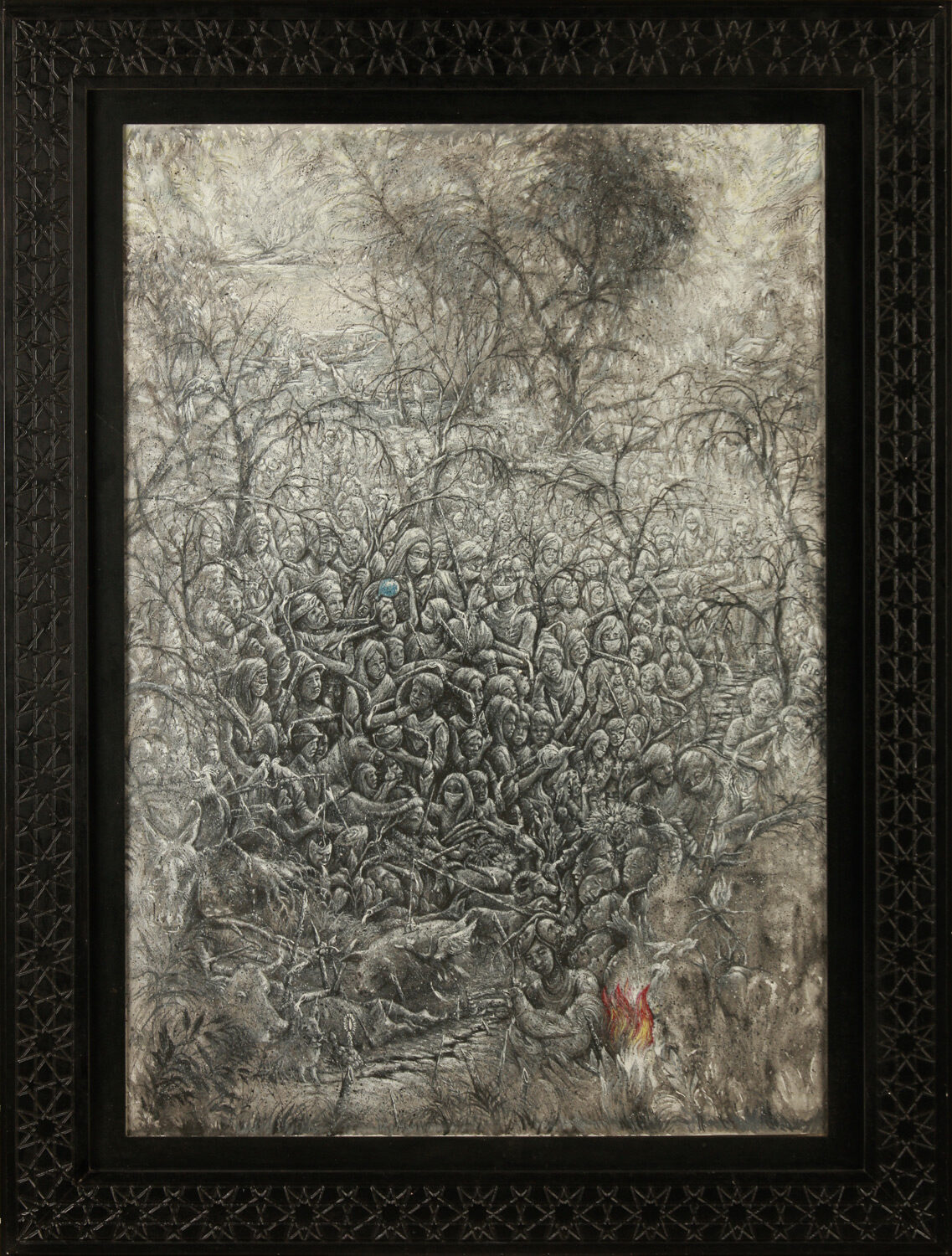
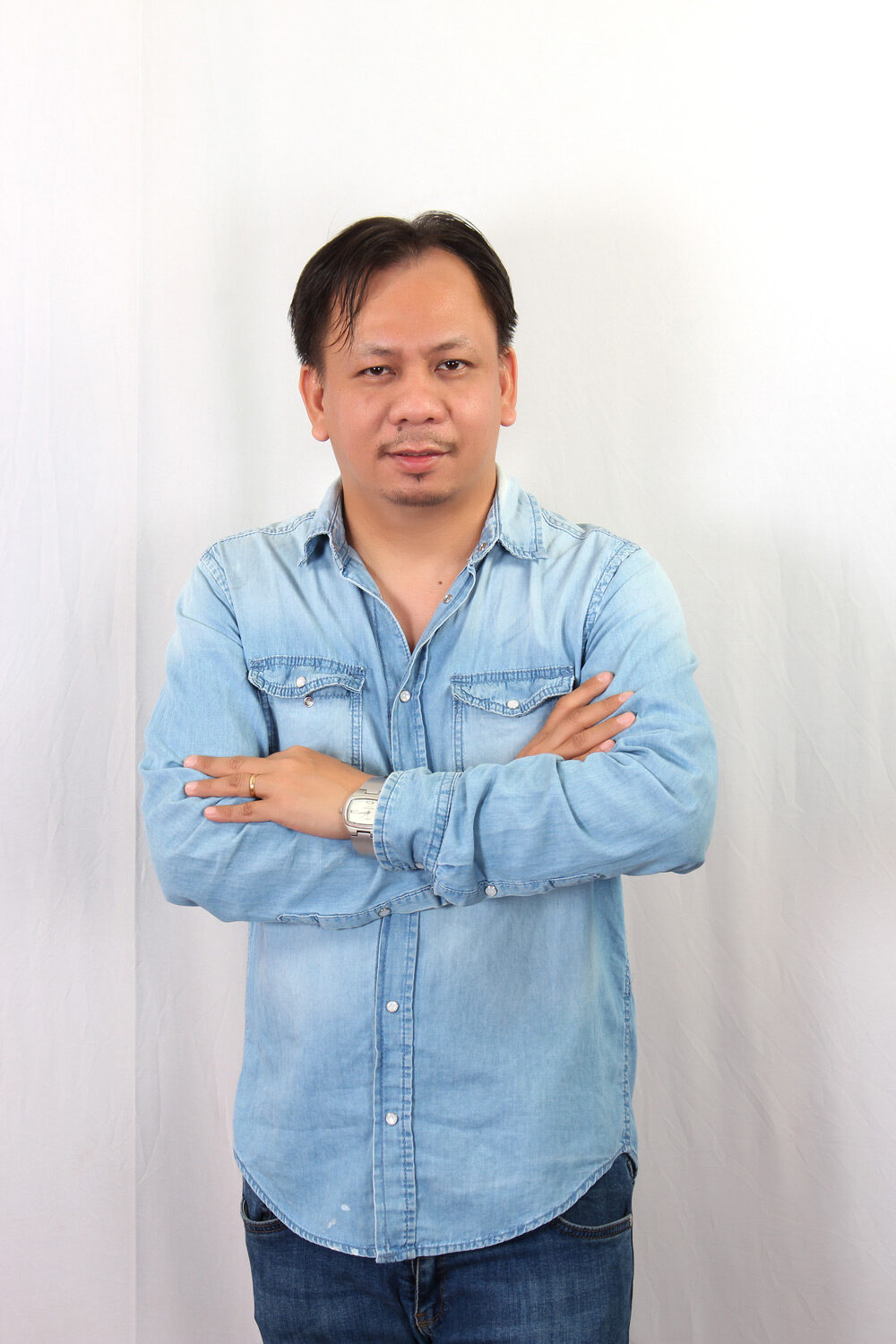
Special Citation
Crispo D. Mantiquilla
“LUCAS 21:11″
Water Media (Gouache) on Paper
39” x 28”
For Crispo Mantiquilla, who has received a Special Citation in the Water media on Paper category, a depiction of the end of times is expressed by the Biblical verse, Lucas 21:11, which provides the title of his work. The verse reads: “And great earthquakes shall be in diverse places, and famines, and pestilences; and fearful sights and great signs shall there be from heaven.”
The piece is occasioned by what the world has been facing recently, from natural and man-made disasters to the ravages of the pandemic that continue to inflict illness and death to millions. Events such as these can’t help but prompt an eschatological view of humanity. For the former overseas Filipino worker-turned-visual artist, the total destruction of the world sees a massive gathering of people as they jostle for space and fight over the most meager of resources. The reference to the current global pandemic is stark, as some of the figures are seen to be wearing masks, painting a scenario of pestilence.
A minuscule but daunting fire burns on the lower right side of the painting, which suggests sacrifice, death, or the purifying flames of the Holy Spirit. This can ultimately be seen as the “great signs…from heaven” alluded to in the Biblical verse. Regardless of the association, the people seem to be moving towards it: otherwise seen as their ultimate destination.
The monochromatic treatment, save for the conflagration and the deflated balloon the color of sky, intensifies the scale of the scene into something that is urgent and oracular, given the worsening climate change, pockets of wars, and the ongoing pandemic.
SCULPTURE RECOGNITION PROGRAM
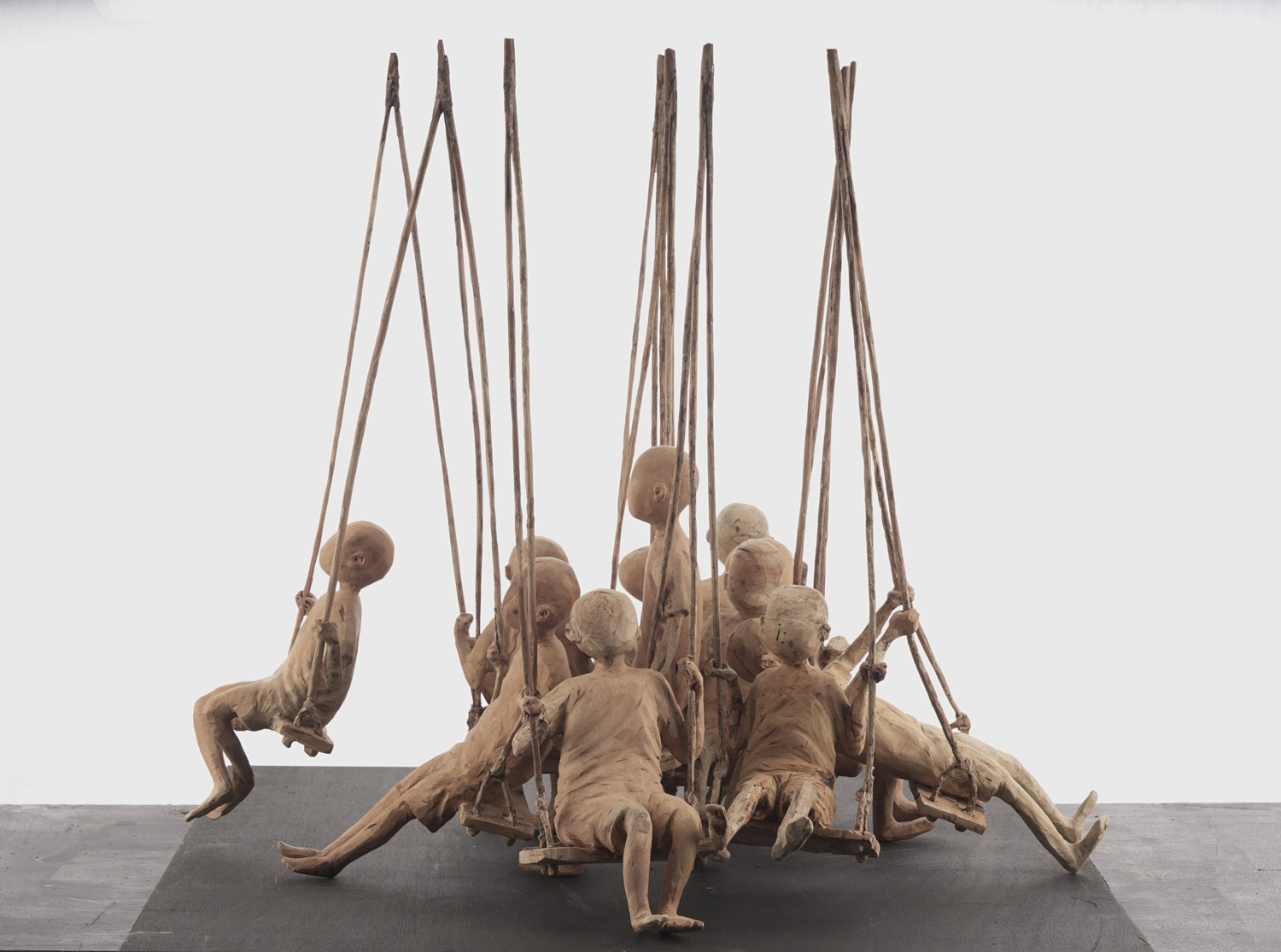
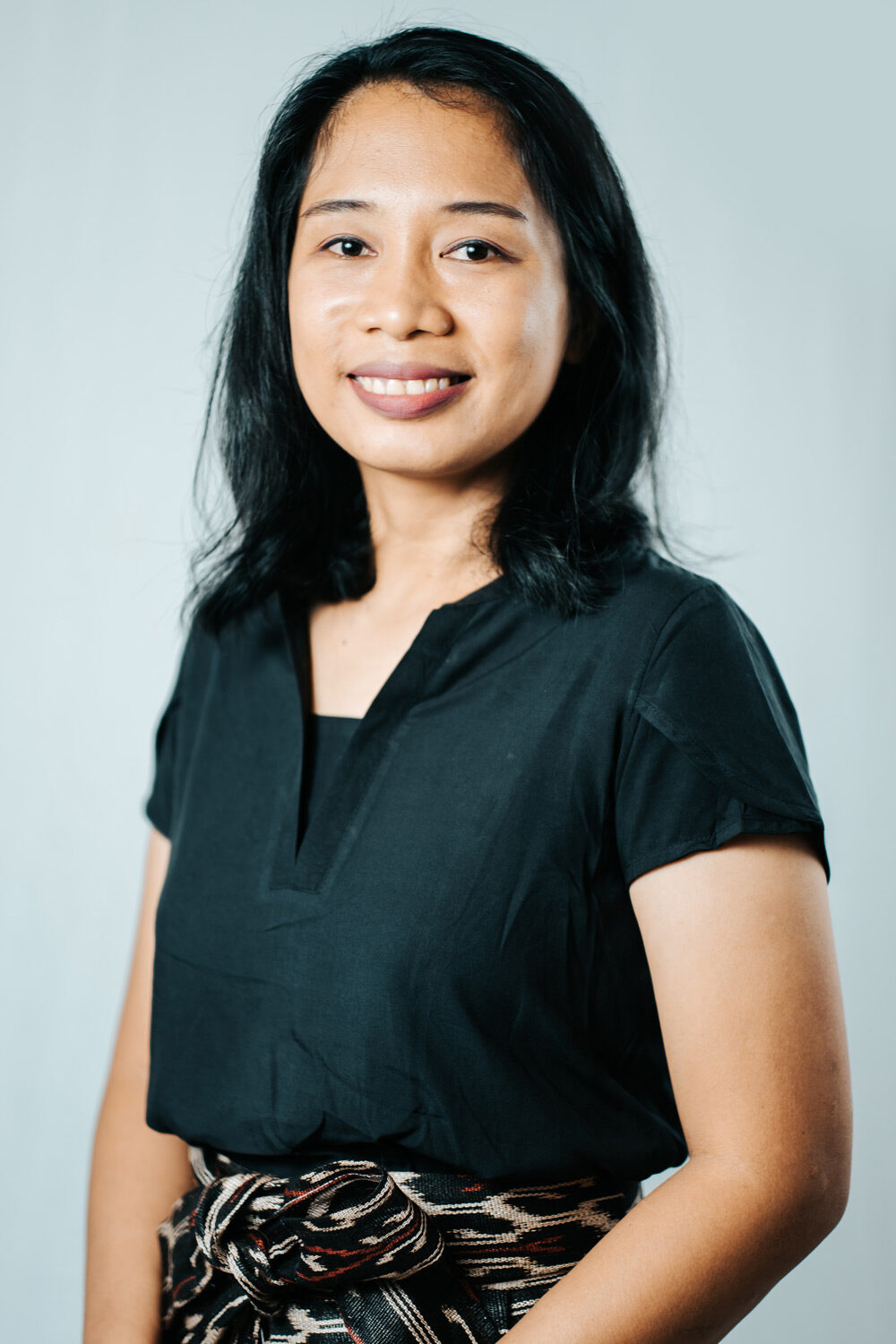
Grand Awardee
Kathleen Sareena D.C. Dagum
“BUNGKAG”
Wood
22” x 21” x 22”
The Grand Awardee for the Sculpture Recognition Program, Kathleen Sareena Dagum, presents her work, Bungkag, as a “depiction of human suppression visualized by the gesture in conflict and chaotic poses” as well as her “perception of the monopolized (lies) system imposed on people.” With the title being the Cebuano word which means “to break apart into constituent parts,” the sculpture captures her vision through a dynamic collection of children on a swing moving inharmoniously with each other, never achieving collective action and unity.
Through an ingenious concealment of the supporting structure, the swings seem to be floating and whose ropes forming triangles seem to be attached to a theoretical bar, giving the impression that the whole piece defies gravity. The work is a magnificent tension between unity and variety, between movement and stillness. Amid the disparate motions of the swings is a solitary figure standing at the center—the hub around the spokes of the wheel—representative of order and rationality in the given chaos.
Poetic and rendered with subtle but impactful beauty, the sculpture depicts how confusion, evoked by the physical and metaphorical orientations of the figures, the different directions to which they look, benefits and is perpetuated by people in power. “Caging people might crumple them, but it will not take too long for the system to collapse,” the artist states. “It is my desire to be a kind of artist that shares significant art in our society: art that has an impact and at the same time that people will love.”
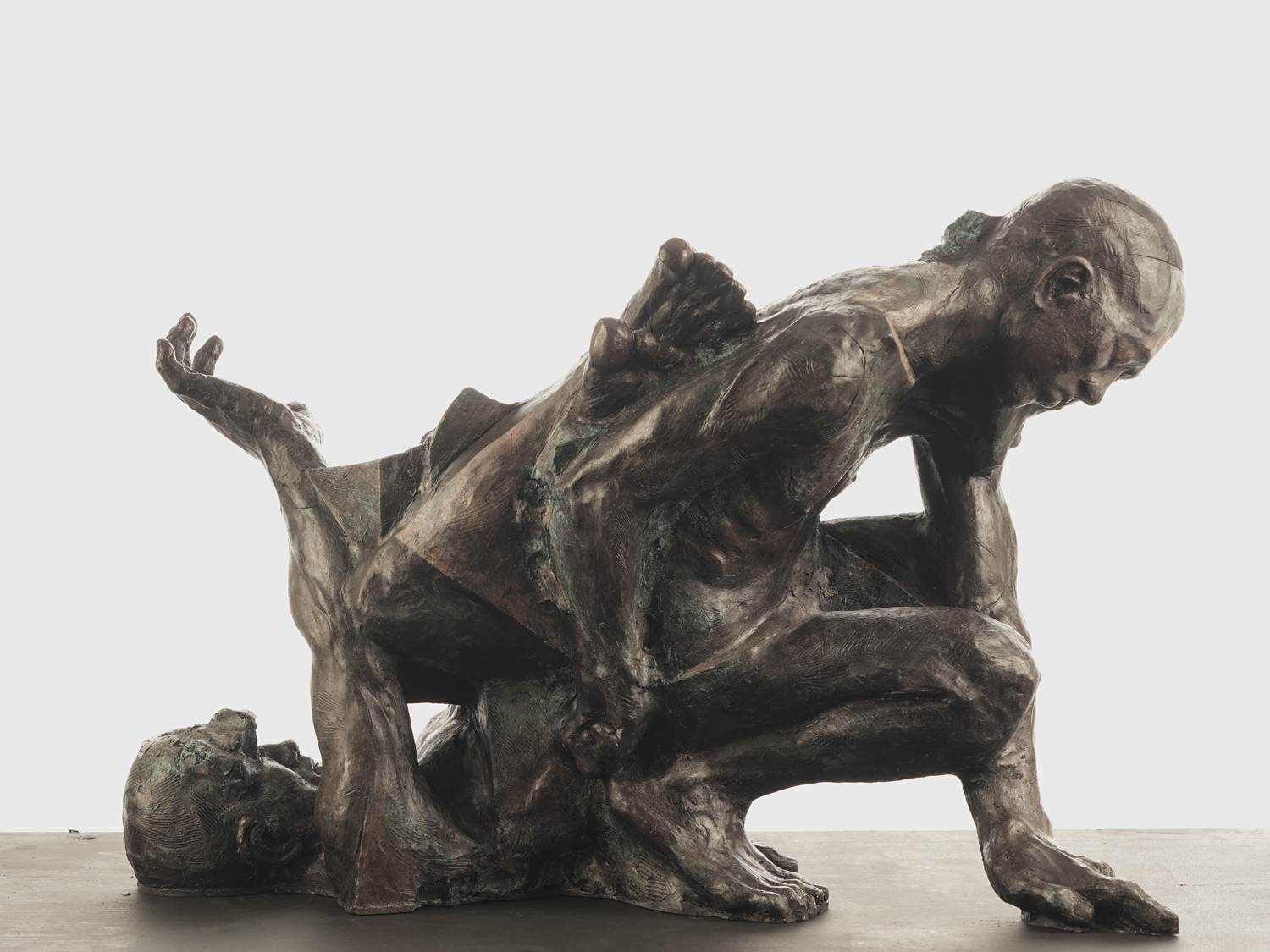
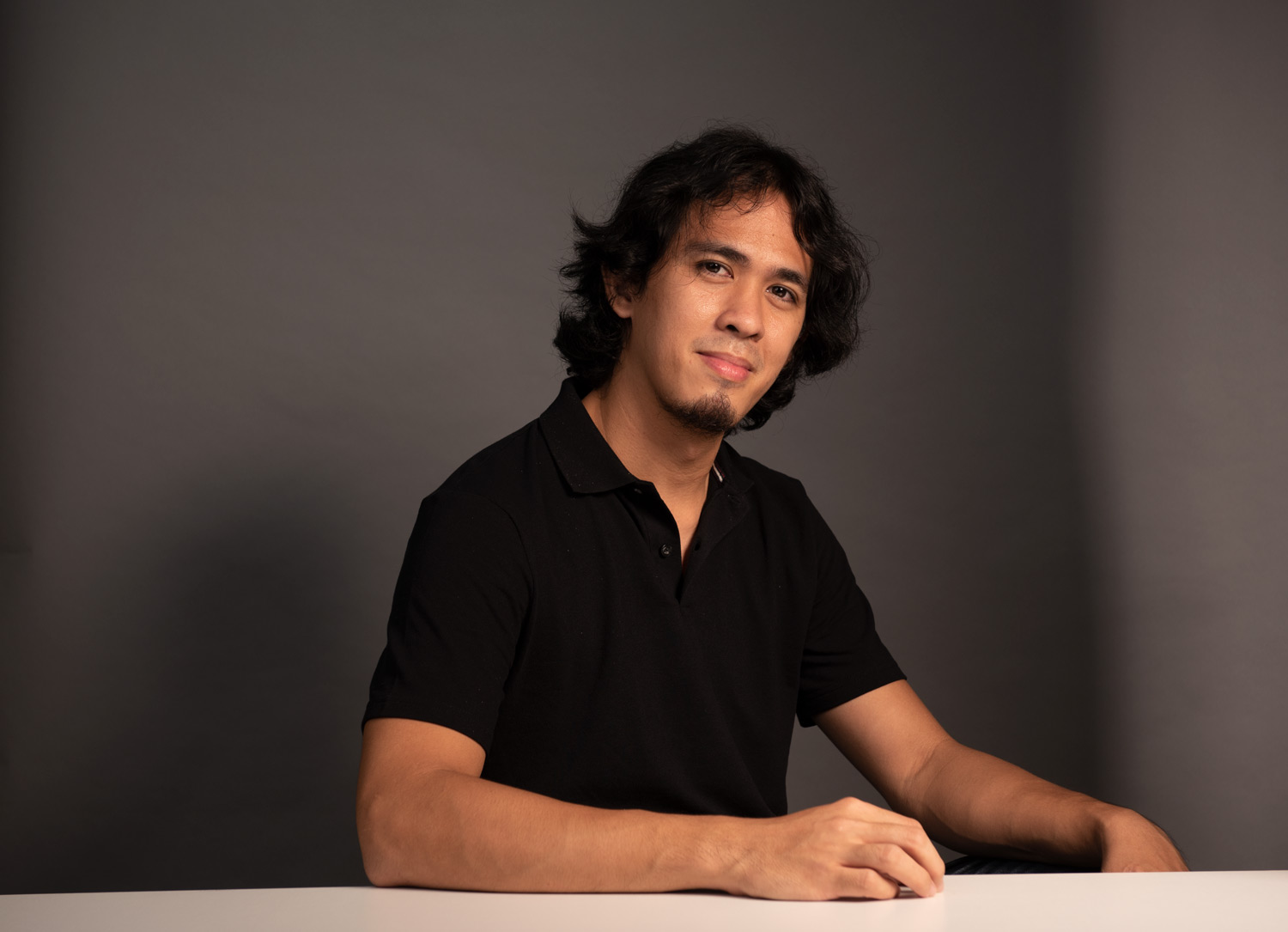
Special Citation
Carlo P. De Laza
“ISANG PANGARAP ANG MANAGINIP “
Resin
19” x 24” x 14”
The recipient of Special Citation for the Sculpture Recognition Program, Carlo De Laza portrays the tension between reaching one’s dreams and simply getting by from day to day in his work, Isang Pangarap ang Managinip. “I tried to express in my work how the value of our hopes (pangarap) and dreams (panaginip) weighs differently among us,” he states. “There is always a side of us trying to reach for the fathomless sky and the side of us just trying to touch the reachable.”
This work, though it is composed of two figures, actually portray just a single man as he struggles to achieve his vision. The supine figure, the supposed dreamer, holds the seated figure that seems to be contemplating on how to manifest his desired future. Stricken with inertia and balancing himself by an arm, the figure appears to be held down by an outside force despite being simultaneously being encouraged and propelled by his inner self.
Such an internal strife is familiar, as trying to achieve one’s dreams is rife with risks and uncertainties. The roughness of the sculptural surface further suggests that the figure is still undergoing an important process of transformation and is yet to achieve self-actualization. In addition to the treatment of the surface to convey unrealized potential, the beauty of the work lies in the juxtaposition of diagonal, horizontal, vertical lines conveyed by the human form. It is a deeply resonant work, one that brings to fore the crisis between lofty ideals and quotidian practicalities.
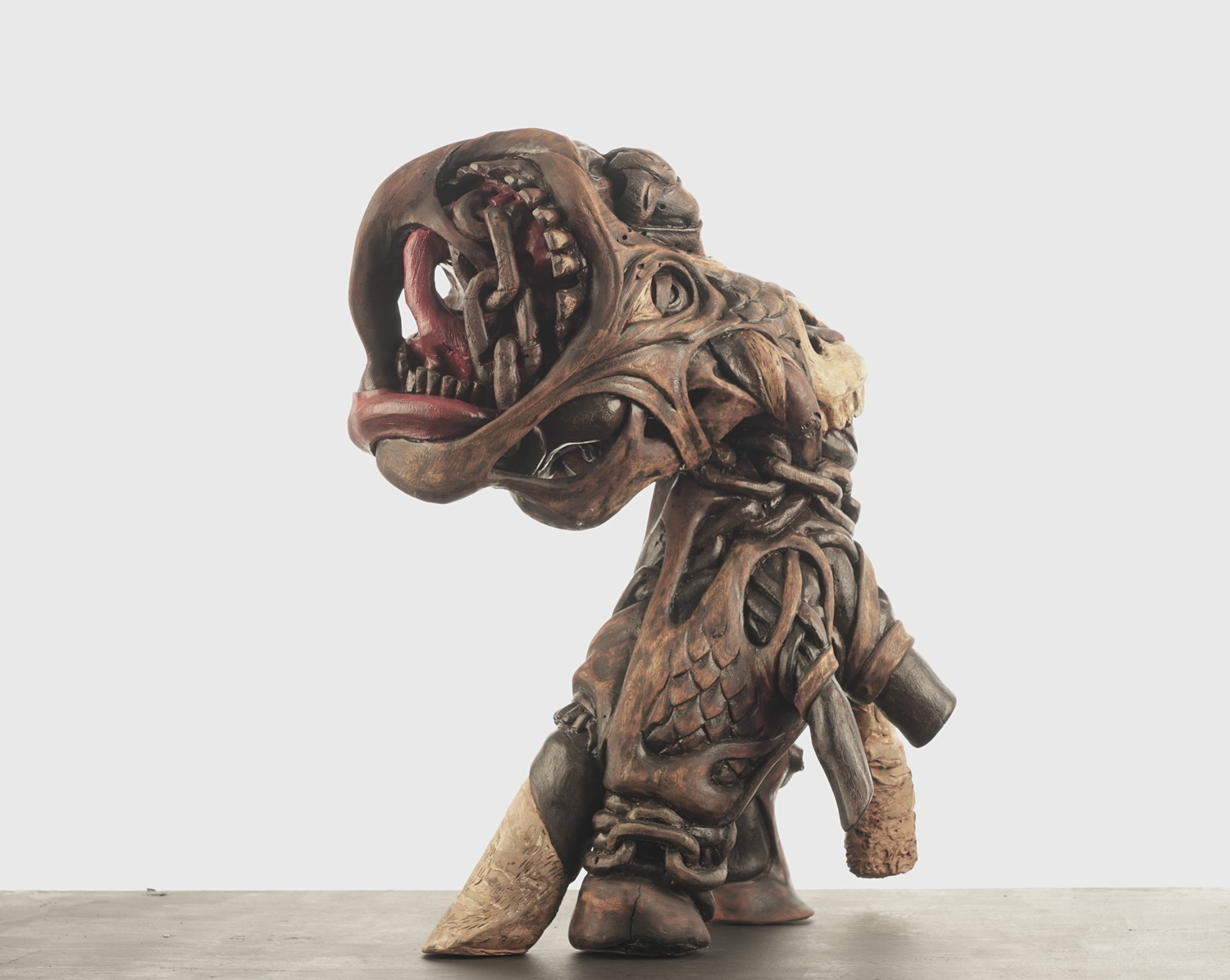
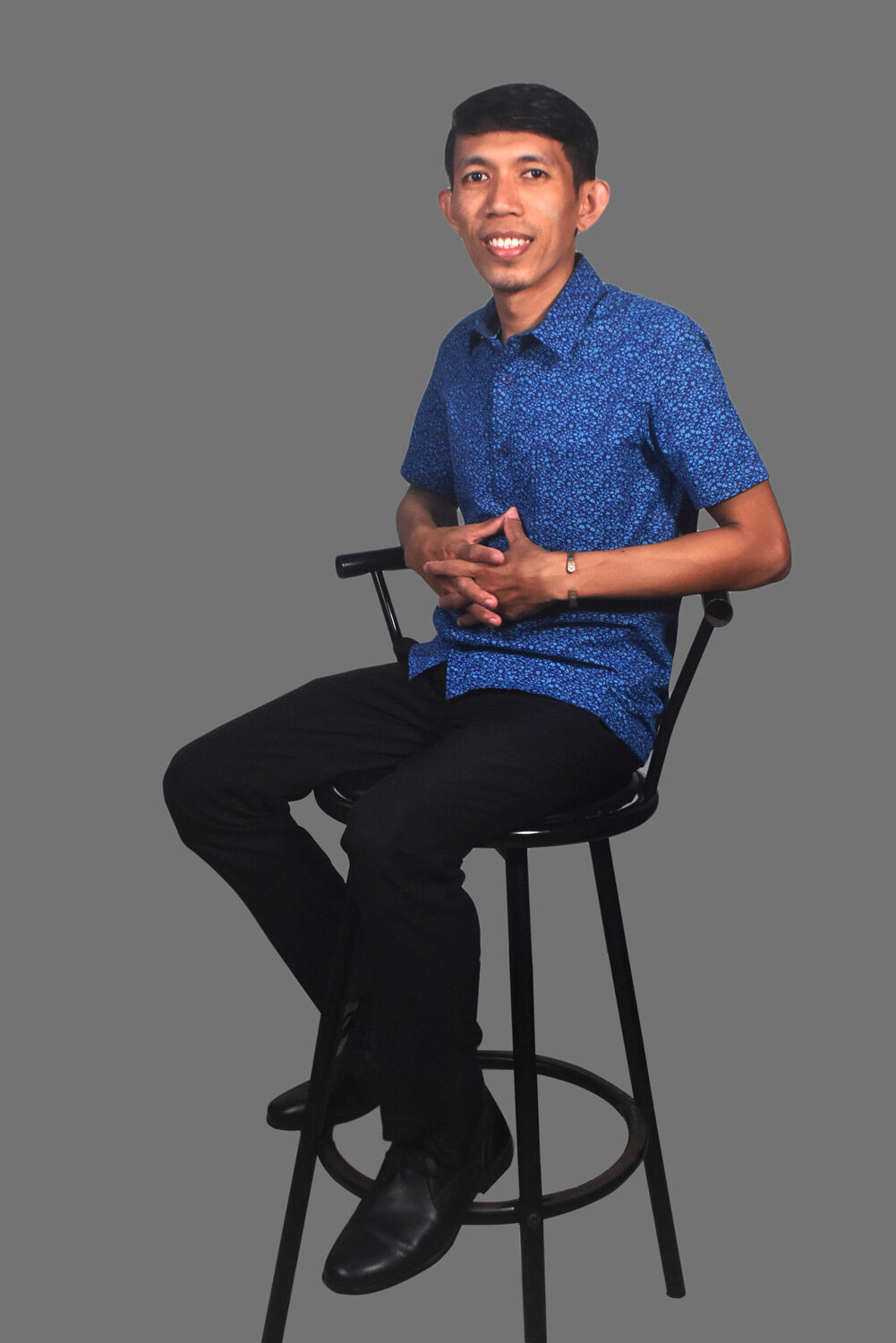
Special Citation
Tyrone Dave E. Espinosa
“Nakakabinging Katahimikan”
Wood
25” x 19” x 12”
In Nakakabinging Katahimikan, Tyrone Dave Espinosa, recipient of a Special Citation for the Sculpture Recognition Program, condenses in a sculptural form the other pandemic, which is the rise of mental health issues. Because of the stigma and the general ignorance that surrounds it, many people choose to suffer in silence, enduring the illness and not seeking medical help for fear of being judged, ostracized, or simply labeled as mad. “Even before the pandemic happened,” states the artist, “depression was already worsening so much so that people would rather end their lives (than seek help).”
Immediately visceral, the work features a deformed human figure, whose tongue, mouth, and lips—which constitute the apparatus of speech—are violently chained. The silence is the result of society’s imposition on people not to speak up about their thoughts and feelings, lest they be seen as an abomination. The internal upheaval intensifies, conveyed by the contorted body of the figure. Long repressed, the anxieties and terrors that attend a mental health crisis soon rise up, manifested as animal parts, such as fish scales and hooves.
The sculpture visually represents what mental illness does in the absence of an intervention: it metaphorically alters the person. Soon, the world loses its flavor and color, the once effortless interaction with people becomes burdensome, the comfort of sleep and appetite become elusive. Horrific as it may look, the sculpture rings a sense of urgency, in light because the suffering of one becomes the suffering of many. For the visual artist, silence, in issues about our emotional and mental well-being, is no longer an option.
With analysis and descriptions of winning pieces by Carlomar Daoana. With additional text by Leo Balante
Rank Magazine is a premier advocacy partner of MADE 2021.
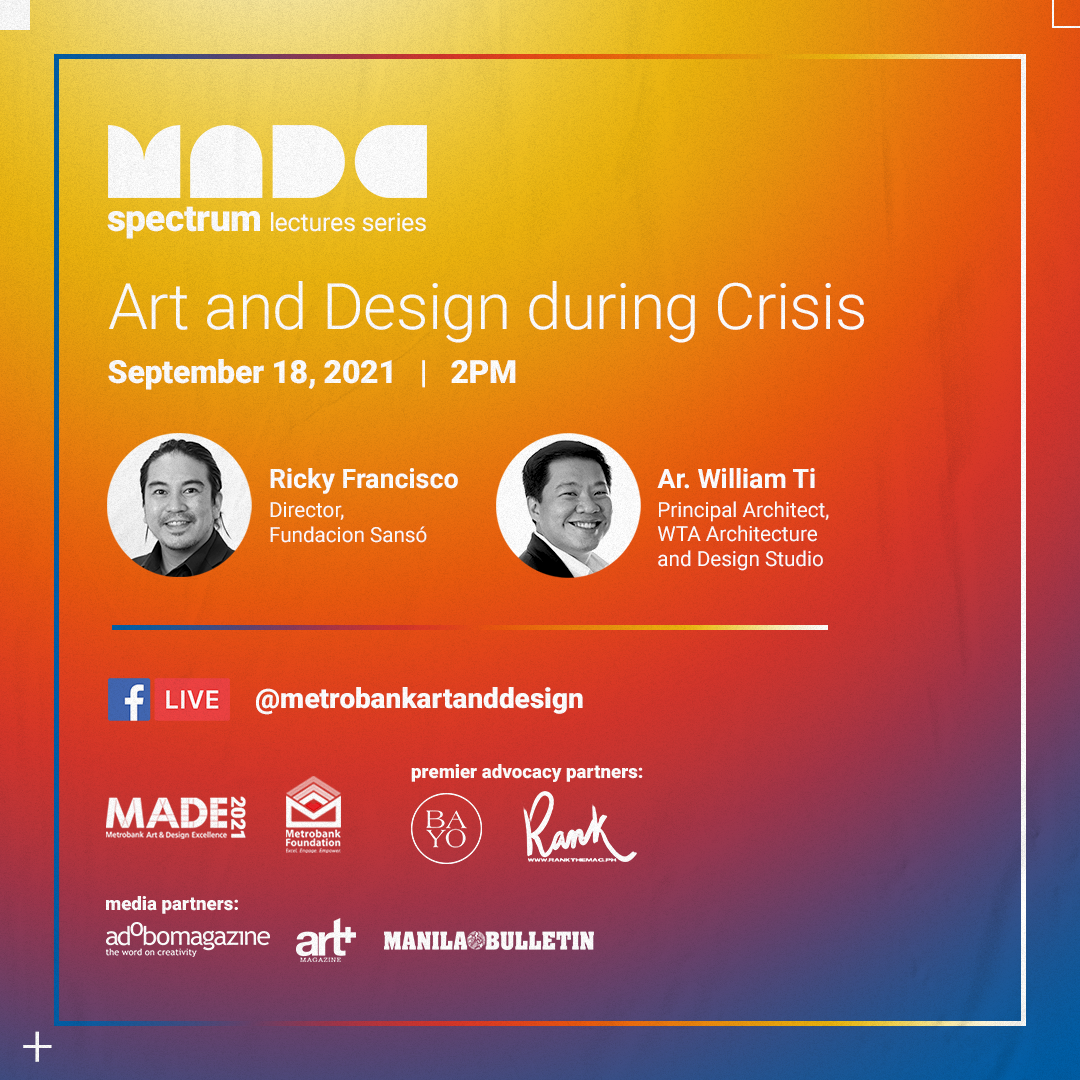

To access the awarding ceremonies and the line-up of events for MADE, please visit www.madeartdepot.ph.
For further details of MADE’s slate of webinar series, follow the official MADE Facebook and Instagram pages @metrobankartanddesign.
